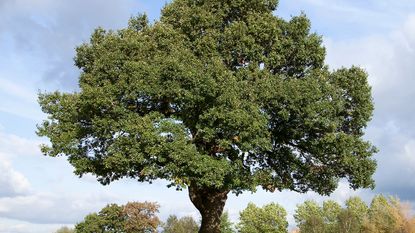History Of Oak Trees - Where Do Oaks Come From


I have a fascination for all trees, but the stunning beauty, strength and longevity of oak trees (Quercus spp.) has made them perhaps the best known and most admired. Our language is full of sayings that celebrate this impressive species: like "strong as an oak" or "from tiny acorns do mighty oaks grow."
The oak is widespread and also impressive in stature, with species growing to more than 100 feet (30 meters) tall. But where do oaks come from? The history of oak trees starts many million years ago and is a story worth the telling. Read on for the highlights of oak tree history.
Oak Tree History
It's always difficult to put your finger on the exact date - or even the century - a species begins. Usually, a particular kind of tree emerges slowly from a lengthy lineage of trees and shrubs, and this is the case of oaks. But one thing is clear in the history of oak trees: oaks have been around a long time.
Oak trees are in the genus Quercus, which is part of the plant family Fagaceae, a family shared with the beech (Fagus spp.) and the chestnut tree (Castanea spp.) Fossil evidence shows that members of this plant family date back to at least the Late Cretaceous (some 85 million years ago).
However, the first fossils directly related to oak tree history appeared some 32 to 35 million years ago, with similar types of trees to modern-day oaks. These first fossils show the actual oak species appeared some 25 million years ago. Now that's a long history. So oak tree history starts millions of years ago. But exactly where do oaks come from?
It is likely that America can claim oaks as our own, since the earliest fossils were found in the present-day state of Georgia. There are over 600 species of trees and shrubs in the oak genus. All are native to the northern hemisphere, from frigid latitudes to tropical Asia and the Americas.
Oak species can be shrubby or majestic, but most have one thing in common - their fruit, called acorns. Oaks are monoecious, meaning that both the male and female flowers are on the same tree. Male flowers (catkins) appear in early spring, triggering many allergies. Female blooms are barely noticeable but will eventually grow to produce acorns. Acorns consist of two components: a nut and a cupule, the cup-like structures that attach them to the tree branch.
Gardening tips, videos, info and more delivered right to your inbox!
Sign up for the Gardening Know How newsletter today and receive a free download of our most popular eBook "How to Grow Delicious Tomatoes."
Interestingly, few acorns actually survive long enough to become trees, since a number of wildlife feed on them. This is yet another amazing thing about oak trees - They still find a way to live on. All it takes is one acorn.

Teo Spengler has been gardening for 30 years. She is a docent at the San Francisco Botanical Garden. Her passion is trees, 250 of which she has planted on her land in France.
-
 7 Best Dwarf Tomato Plants
7 Best Dwarf Tomato PlantsHave a tiny growing space? Look for dwarf tomato seeds so you don’t miss out on summer’s juicy bounty.
By Susan Albert
-
 5 Night-Blooming Houseplants – Grow An Indoor Moon Garden
5 Night-Blooming Houseplants – Grow An Indoor Moon GardenThere is something uniquely special about night-blooming houseplants. Set the scene for a magical evening indoors with these fragrant flowering beauties.
By Amy Grant